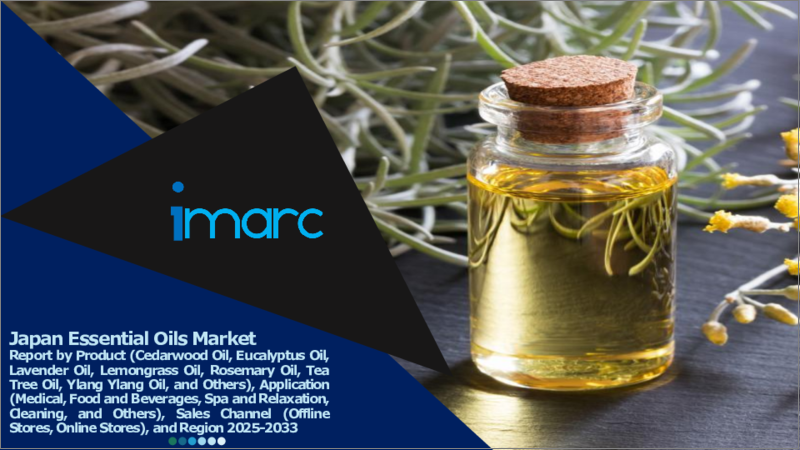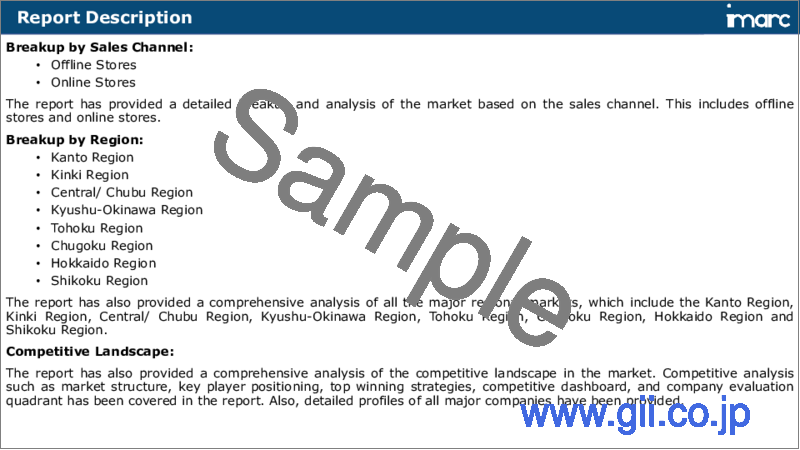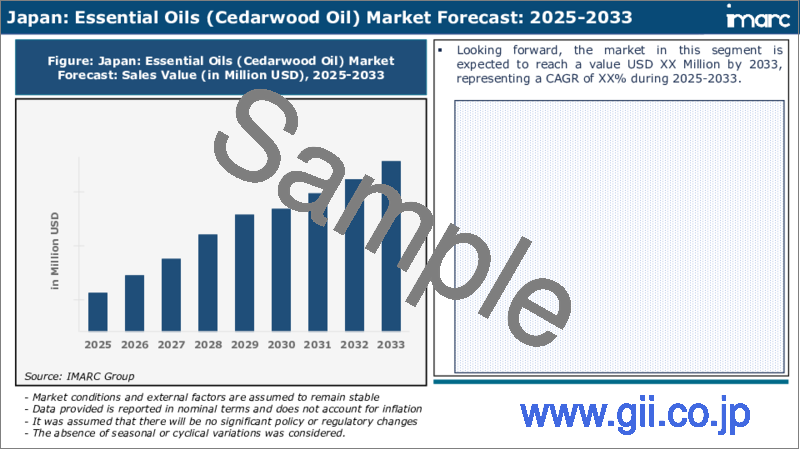|
|
市場調査レポート
商品コード
1729378
日本のエッセンシャルオイル市場レポート:製品、用途、販売チャネル、地域別、2025年~2033年Japan Essential Oils Market Report by Product, Application, Sales Channel, and Region 2025-2033 |
||||||
カスタマイズ可能
|
|||||||
| 日本のエッセンシャルオイル市場レポート:製品、用途、販売チャネル、地域別、2025年~2033年 |
|
出版日: 2025年05月01日
発行: IMARC
ページ情報: 英文 119 Pages
納期: 5~7営業日
|
- 全表示
- 概要
- 目次
日本のエッセンシャルオイル市場規模は2024年に3億8,670万米ドルに達しました。今後、IMARC Groupは、同市場が2033年までに7億8,520万米ドルに達し、2025年から2033年にかけて7.78%の成長率(CAGR)を示すと予測しています。環境に優しい成分への嗜好の発展、ヘルスケア分野やアロマセラピーでの幅広い利用、継続的な研究開発(R&D)、製品の多様化の高まり、カスタマイズやコラボレーションの増加などが市場を牽引する主な要因です。
本レポートで扱う主な質問
- 日本のエッセンシャルオイル市場はこれまでどのように推移し、今後どのように推移するのか?
- COVID-19が日本のエッセンシャルオイル市場に与えた影響は?
- 日本のエッセンシャルオイル市場の製品別区分は?
- 日本のエッセンシャルオイル市場の用途別区分は?
- 日本のエッセンシャルオイル市場の販売チャネル別区分は?
- 日本のエッセンシャルオイル市場のバリューチェーンにおける様々なステージとは?
- 日本のエッセンシャルオイル市場の主な促進要因と課題は何か?
- 日本のエッセンシャルオイル市場の構造と主要プレーヤーは?
- 日本のエッセンシャルオイル市場における競合の程度は?
目次
第1章 序文
第2章 調査範囲と調査手法
- 調査の目的
- ステークホルダー
- データソース
- 市場推定
- 調査手法
第3章 エグゼクティブサマリー
第4章 日本のエッセンシャルオイル市場:イントロダクション
- 概要
- 市場力学
- 業界動向
- 競合情報
第5章 日本のエッセンシャルオイル市場情勢
- 過去および現在の市場動向(2019~2024年)
- 市場予測(2025~2033年)
第6章 日本のエッセンシャルオイル市場:製品別の内訳
- シダーウッドオイル
- ユーカリオイル
- ラベンダーオイル
- レモングラスオイル
- ローズマリーオイル
- ティーツリーオイル
- イランイランオイル
- その他
第7章 日本のエッセンシャルオイル市場:用途別の内訳
- 医療
- 飲食品
- スパとリラクゼーション
- クリーニング
- その他
第8章 日本のエッセンシャルオイル市場:販売チャネル別の内訳
- オフラインストア
- オンラインストア
第9章 日本のエッセンシャルオイル市場:競合情勢
- 概要
- 市場構造
- 市場企業のポジショニング
- 主要成功戦略
- 競合ダッシュボード
- 企業評価象限
第10章 主要企業のプロファイル
第11章 日本のエッセンシャルオイル市場:業界分析
- 促進要因、抑制要因、機会
- ポーターのファイブフォース分析
- バリューチェーン分析
第12章 付録
The Japan essential oils market size reached USD 386.7 Million in 2024. Looking forward, IMARC Group expects the market to reach USD 785.2 Million by 2033, exhibiting a growth rate (CAGR) of 7.78% during 2025-2033. The growing preference for eco-friendly ingredients, widespread utilization in the healthcare sector and aromatherapy, ongoing research and development (R&D), rising product diversification, increasing customization and collaborations represent some of the key factors driving the market.
Essential oils are concentrated, aromatic liquids extracted from various plant sources through a meticulous distillation or cold-press process. These oils capture the essence of the plants from which they are derived, including herbs, flowers, fruits, and trees. They are renowned for their potent fragrance and therapeutic properties and are utilized in various industries, such as healthcare, cosmetics, and aromatherapy. Essential oils possess a wide range of properties, including antimicrobial, anti-inflammatory, and analgesic effects. They are used for aromatherapy to promote relaxation, alleviate stress, and improve mood. These oils can be diluted and used for massage, skincare, and as natural remedies for various ailments. Essential oils also have antiseptic qualities, making them valuable for disinfecting surfaces or air purification. They can help alleviate symptoms of common ailments, like headaches, insomnia, and muscle pain. Some oils, such as lavender and chamomile, are renowned for their calming effects and are used to induce sleep or reduce anxiety. Essential oils, like tea tree and eucalyptus, are known for their antimicrobial properties and can be used for wound care or cleaning products.
Japan Essential Oils Market Trends/Drivers:
The growing preference for natural and eco-friendly ingredients in various industries, including cosmetics, personal care, and home fragrances, is one of the major factors contributing to the market growth. Additionally, the increasing utilization of essential oils in the healthcare sector aiming to enhance patient comfort, reduce anxiety, and support recovery processes, is providing a considerable boost to the market growth. In line with this, the widespread application of essential oils in aromatherapy due to their calming and mood-enhancing properties that help alleviate stress, anxiety, and insomnia, is strengthening the market growth. Moreover, the ongoing research and development (R&D) of evidence-based practices in clinical trials and studies to validate the efficacy and safety of essential oil therapies in various healthcare applications is positively impacting the market growth. In addition to this, the growing emphasis on self-care and wellness in the Japanese culture, encouraging consumers to turn to essential oils for their potential benefits in skincare, haircare, and relaxation, is providing a thrust to the market growth. In confluence with this, the incorporation of essential oils into diverse product formulations, such as perfumes and lotions, essential oil-infused clothing, and bedding, which offer aromatherapeutic benefits during daily routines and sleep, is favoring the market growth. Additionally, the sudden shift towards customization as companies offer personalized essential oil blends, catering to specific therapeutic needs, enhancing their appeal among consumers seeking tailor-made wellness solutions, is propelling the market growth. Furthermore, the increasing collaboration between essential oil producers and various industries, such as partnerships with the hospitality sector leading to the utilization of essential oils in hotel amenities and spa services, elevating the overall guest experience, are creating remunerative growth opportunities for the market.
Japan Essential Oils Industry Segmentation:
Breakup by Product:
- Cedarwood Oil
- Eucalyptus Oil
- Lavender Oil
- Lemongrass Oil
- Rosemary Oil
- Tea Tree Oil
- Ylang Ylang Oil
- Others
Breakup by Application:
- Medical
- Pharmaceuticals
- Nutraceuticals
- Food and Beverages
- Bakery and Confectionery
- Beverages
- Meat, Poultry and Seafood
- Others
- Spa and Relaxation
- Aromatherapy
- Personal Care
- Cosmetics
- Toiletries
- Others
- Cleaning
- Kitchen Cleaners
- Floor Cleaners
- Bathroom Cleaner
- Others
- Others
Breakup by Sales Channel:
- Offline Stores
- Online Stores
Competitive Landscape:
The report has also provided a comprehensive analysis of the competitive landscape in the market. Competitive analysis such as market structure, key player positioning, top winning strategies, competitive dashboard, and company evaluation quadrant has been covered in the report. Also, detailed profiles of all major companies have been provided.
Key Questions Answered in This Report:
- How has the Japan essential oils market performed so far and how will it perform in the coming years?
- What has been the impact of COVID-19 on the Japan essential oils market?
- What is the breakup of the Japan essential oils market on the basis of product?
- What is the breakup of the Japan essential oils market on the basis of application?
- What is the breakup of the Japan essential oils market on the basis of sales channel?
- What are the various stages in the value chain of the Japan essential oils market?
- What are the key driving factors and challenges in the Japan essential oils market?
- What is the structure of the Japan essential oils market and who are the key players?
- What is the degree of competition in the Japan essential oils market?
Table of Contents
1 Preface
2 Scope and Methodology
- 2.1 Objectives of the Study
- 2.2 Stakeholders
- 2.3 Data Sources
- 2.3.1 Primary Sources
- 2.3.2 Secondary Sources
- 2.4 Market Estimation
- 2.4.1 Bottom-Up Approach
- 2.4.2 Top-Down Approach
- 2.5 Forecasting Methodology
3 Executive Summary
4 Japan Essential Oils Market - Introduction
- 4.1 Overview
- 4.2 Market Dynamics
- 4.3 Industry Trends
- 4.4 Competitive Intelligence
5 Japan Essential Oils Market Landscape
- 5.1 Historical and Current Market Trends (2019-2024)
- 5.2 Market Forecast (2025-2033)
6 Japan Essential Oils Market - Breakup by Product
- 6.1 Cedarwood Oil
- 6.1.1 Overview
- 6.1.2 Historical and Current Market Trends (2019-2024)
- 6.1.3 Market Forecast (2025-2033)
- 6.2 Eucalyptus Oil
- 6.2.1 Overview
- 6.2.2 Historical and Current Market Trends (2019-2024)
- 6.2.3 Market Forecast (2025-2033)
- 6.3 Lavender Oil
- 6.3.1 Overview
- 6.3.2 Historical and Current Market Trends (2019-2024)
- 6.3.3 Market Forecast (2025-2033)
- 6.4 Lemongrass Oil
- 6.4.1 Overview
- 6.4.2 Historical and Current Market Trends (2019-2024)
- 6.4.3 Market Forecast (2025-2033)
- 6.5 Rosemary Oil
- 6.5.1 Overview
- 6.5.2 Historical and Current Market Trends (2019-2024)
- 6.5.3 Market Forecast (2025-2033)
- 6.6 Tea Tree Oil
- 6.6.1 Overview
- 6.6.2 Historical and Current Market Trends (2019-2024)
- 6.6.3 Market Forecast (2025-2033)
- 6.7 Ylang Ylang Oil
- 6.7.1 Overview
- 6.7.2 Historical and Current Market Trends (2019-2024)
- 6.7.3 Market Forecast (2025-2033)
- 6.8 Others
- 6.8.1 Historical and Current Market Trends (2019-2024)
- 6.8.2 Market Forecast (2025-2033)
7 Japan Essential Oils Market - Breakup by Application
- 7.1 Medical
- 7.1.1 Overview
- 7.1.2 Historical and Current Market Trends (2019-2024)
- 7.1.3 Market Segmentation
- 7.1.3.1 Pharmaceuticals
- 7.1.3.2 Nutraceuticals
- 7.1.4 Market Forecast (2025-2033)
- 7.2 Food and Beverages
- 7.2.1 Overview
- 7.2.2 Historical and Current Market Trends (2019-2024)
- 7.2.3 Market Segmentation
- 7.2.3.1 Bakery and Confectionery
- 7.2.3.2 Beverages
- 7.2.3.3 Meat, Poultry and Seafood
- 7.2.3.4 Others
- 7.2.4 Market Forecast (2025-2033)
- 7.3 Spa and Relaxation
- 7.3.1 Overview
- 7.3.2 Historical and Current Market Trends (2019-2024)
- 7.3.3 Market Segmentation
- 7.3.3.1 Aromatherapy
- 7.3.3.2 Personal Care
- 7.3.3.3 Cosmetics
- 7.3.3.4 Toiletries
- 7.3.3.5 Others
- 7.3.4 Market Forecast (2025-2033)
- 7.4 Cleaning
- 7.4.1 Overview
- 7.4.2 Historical and Current Market Trends (2019-2024)
- 7.4.3 Market Segmentation
- 7.4.3.1 Kitchen Cleaners
- 7.4.3.2 Floor Cleaners
- 7.4.3.3 Bathroom Cleaner
- 7.4.3.4 Others
- 7.4.4 Market Forecast (2025-2033)
- 7.5 Others
- 7.5.1 Historical and Current Market Trends (2019-2024)
- 7.5.2 Market Forecast (2025-2033)
8 Japan Essential Oils Market - Breakup by Sales Channel
- 8.1 Offline Stores
- 8.1.1 Overview
- 8.1.2 Historical and Current Market Trends (2019-2024)
- 8.1.3 Market Forecast (2025-2033)
- 8.2 Online Stores
- 8.2.1 Overview
- 8.2.2 Historical and Current Market Trends (2019-2024)
- 8.2.3 Market Forecast (2025-2033)
9 Japan Essential Oils Market - Competitive Landscape
- 9.1 Overview
- 9.2 Market Structure
- 9.3 Market Player Positioning
- 9.4 Top Winning Strategies
- 9.5 Competitive Dashboard
- 9.6 Company Evaluation Quadrant
10 Profiles of Key Players
- 10.1 Company A
- 10.1.1 Business Overview
- 10.1.2 Services Offered
- 10.1.3 Business Strategies
- 10.1.4 SWOT Analysis
- 10.1.5 Major News and Events
- 10.2 Company B
- 10.2.1 Business Overview
- 10.2.2 Services Offered
- 10.2.3 Business Strategies
- 10.2.4 SWOT Analysis
- 10.2.5 Major News and Events
- 10.3 Company C
- 10.3.1 Business Overview
- 10.3.2 Services Offered
- 10.3.3 Business Strategies
- 10.3.4 SWOT Analysis
- 10.3.5 Major News and Events
- 10.4 Company D
- 10.4.1 Business Overview
- 10.4.2 Services Offered
- 10.4.3 Business Strategies
- 10.4.4 SWOT Analysis
- 10.4.5 Major News and Events
- 10.5 Company E
- 10.5.1 Business Overview
- 10.5.2 Services Offered
- 10.5.3 Business Strategies
- 10.5.4 SWOT Analysis
- 10.5.5 Major News and Events
11 Japan Essential Oils Market - Industry Analysis
- 11.1 Drivers, Restraints and Opportunities
- 11.1.1 Overview
- 11.1.2 Drivers
- 11.1.3 Restraints
- 11.1.4 Opportunities
- 11.2 Porters Five Forces Analysis
- 11.2.1 Overview
- 11.2.2 Bargaining Power of Buyers
- 11.2.3 Bargaining Power of Suppliers
- 11.2.4 Degree of Competition
- 11.2.5 Threat of New Entrants
- 11.2.6 Threat of Substitutes
- 11.3 Value Chain Analysis






